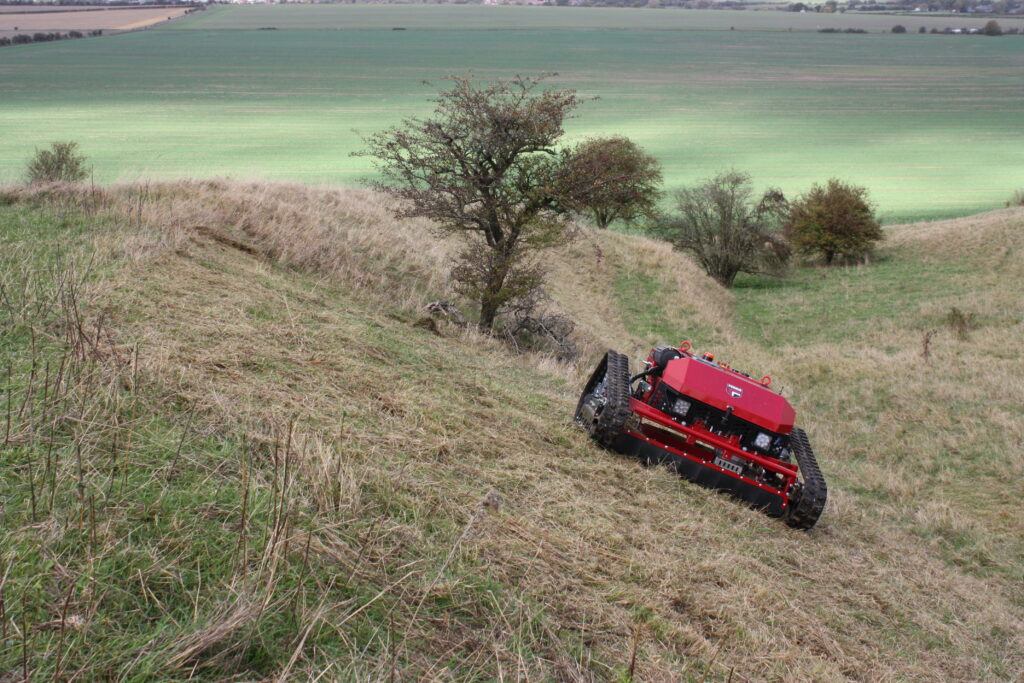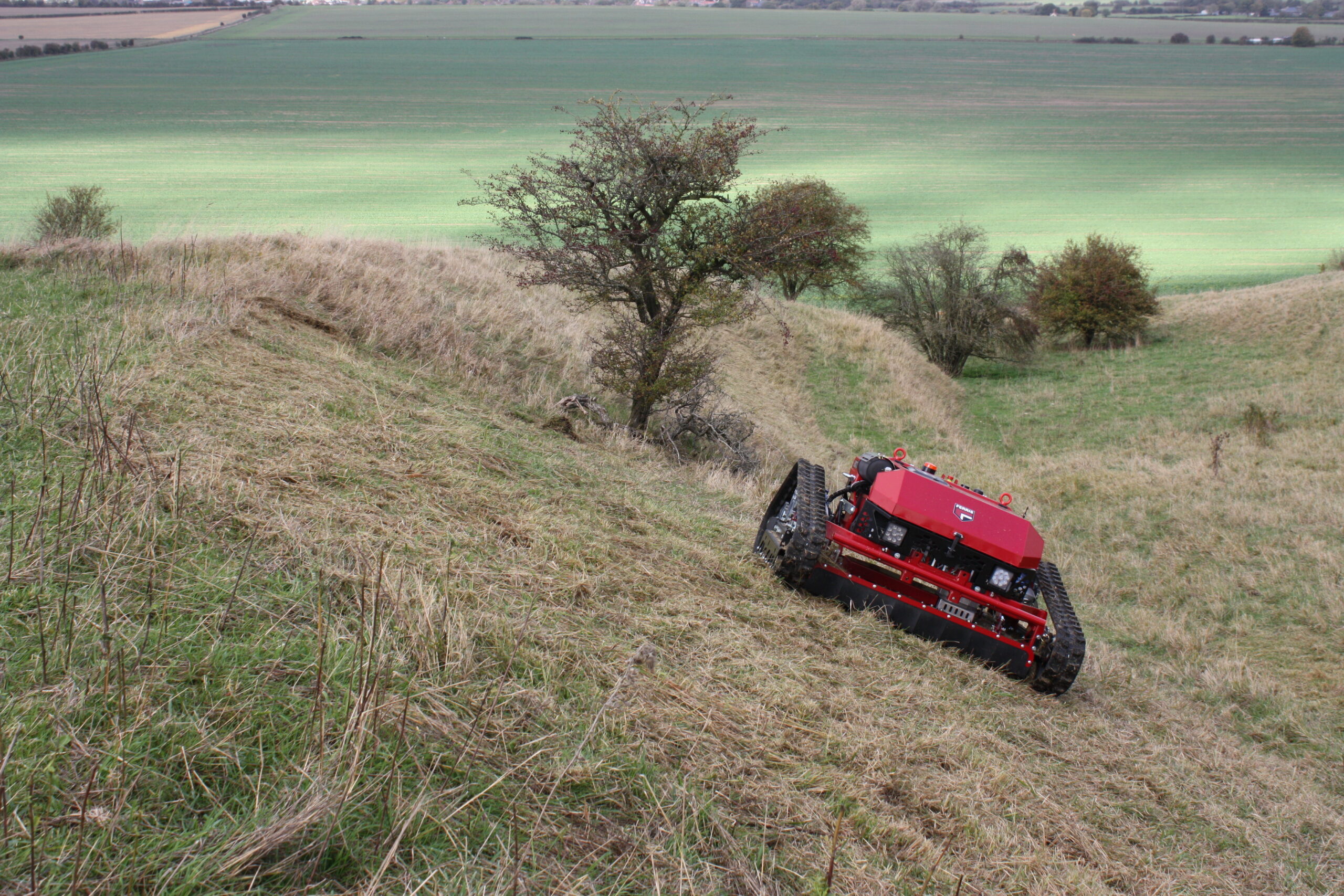
Demand for remotely operated mowers (RCM) is growing rapidly, and there are good reasons for this. Many mowing operations, where a universal mower cannot be used due to dangerous conditions such as steep slopes, close proximity to canals and water reservoirs, slip roads on motorways, noise barriers, and landfills, have increased. The RCM is also a great solution in scenarios where operators of brush cutters or rough terrain mowers are exposed to danger, such as along traffic roads and railroads. Then there are mowing operations where vegetation (brambles, thorn bushes) or accessibility is the limiting factor, such as at solar parks. There are numerous RCMs on the market, here are 7 reasons to choose the Ferris FRC7 to protect your employees whilst having excellent productivity:
-
Safety first
Apart from the undeniable advantages of an RCM in general, the FRC7 has undergone rigorous safety test including EN12733:2019 (“Thrown Objects”) and EN14982:2009-12 (“Electromagnetic Compatibility”). The FRC7 does not compromise on operator safety!
-
True Hybrid Drive
E-motors are powered by replaceable batteries, which in turn are powered by a 23HP Vanguard EFI/ETC motor, which is almost like an idle engine primary, just making sure that the batteries are fully charged. This ensures that without load changes fuel use is very sparing, so run time can reach 8 hours a day without refuelling. FRC7 can travel also utilising batteries at 58 dBA up to 250 m before the generator kicks in. This product feature is also particularly useful when you unexpectedly run out of petrol at the top of a slope and you want the machine to return. Sealed and brushless drive E-motors work very responsively without delays (main reason for losing track in general*) thanks to the direct provision of power from the batteries. There is always maximum power drive available on steep slopes with no direct draw from the generator.
-
No overloading of transmissions
Whilst the electric PTO is under heavy load in tall grass situations, the result is significantly less wear and downtime for the FRC7 vs competition. FRC7 electric motors slowly rev up under load to extend the lifetime of the belt (preventing any clutch issues). FRC7 automatically adjusts the drive speed when the blade speed drops due to dense vegetation and compensates without the intervention of the operator, always providing maximum blade performance and efficiency.
-
Capable of handling steep slopes up to max 55° (143%)
In such cases, the engine needs extra protection. A Dedicated Oil Loop system is fitted: Although the oil pick up is in the middle of a wet sump, at inclinations greater than >35 degrees, oil passed through the sump pressure relief valve is collected in a reservoir and returned to the crankcase. Vapours are first collected in a oil separator. This prevents unnecessary combustion of oil (possibly resulting in too low oil level) and no pressure is built up in the cylinder head with possible result of internal engine damage (Hydraulic Lock).
-
Bi-directional mowing (cutting width: 115cm)
No damage to turf due to turning at the end of cutting rows (especially the case with heavy outfront alternatives). Rutting and erosion of surface is then avoided. Weighing 685kg, the FRC7 remains below the recognised maximum limit of 750kg.
-
Mowing Technology
Two off-set blade spindles with cross-cut swing-tip blades, process up to 50 mm vegetation. The Vehicle Control Unit (VCU) constantly measures the load (you can’t stall the engine; electric motor with load sensing functionality will adjust drive speed to 40%, 20% or shut-off). B-section belts drives cast iron pulleys and protects the spindles for damage from impacts. The rotary mowing process is friendlier to biodiversity than flail alternatives, and the FRC7’s zero turning radius makes it ideal for meandering (Sinus) mowing.
-
Connected CAN bus technology
The information used by the system is recorded and when the mower has a mobile data connection (permanent GPS/Mobile data), it stores it in a database via the cloud. Can-bus communication: system self-diagnosis, premature issue detection. Logging system parameters: working speed, location mapping, working inclines, power draw and component temperatures. Remote service access/assistance.
There is so much more to share about this amazing Ferris FRC7! Get in touch with your Area Sales Manager today to provide a demonstration.
*Running off tracks is usually caused by abrupt steering correction in the direction of travel. Conventional RMCs that do not have electric drive motors use hydrostatic drives, which react to a sudden steering command with a delay, so the reaction is often too late and abrupt. Correcting and trimming the straight-line driving direction on slopes is also not necessary with the FRC7: a stepper motor is counting the rpm’s of each track and adjusting when necessary during the drive. Drive wheel and 2 diverting wheels keep the track in place, with toothed wheels locating through the rubber tracks to keep them in place, together with CT2 (mini-digger system) track roller guards system. Long Pitch prevents grass and dirt building up between the cams. Higher idler sprockets allow the tracks to climb over obstacles. Tool-less track tensioning is also achieved




